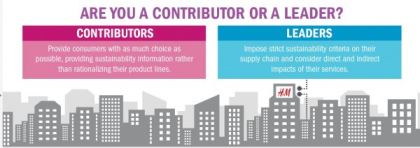Sustainability is one of the major trends facing retailers in a consumer-driven marketplace.
As mentioned by Marian Salzman at NRF, sustainability is one of the major trends facing retailers in a consumer-driven marketplace. Retailers face a consumer that expects environmental transparency from anyone providing goods or services today. What does this mean to the modern retailer? You need to be able to track and document your environmental initiatives.
Sustainability is Still a New Topic for Many Retailers
Even though many of us consumers are committed to living more sustainable lives through supporting a more sustainable economy (at least we think we are; I got some ‘aha’ moments myself from one of Hans Rosling’s TED talks), this is still a new topic for many retailers. How many retailers actually have a sustainability strategy in place? And, if so, have a strategy that reflects the company’s priorities, operating environment, assets and challenges, and with a strong commitment from senior executives? Need help with defining a strategy that supports your business processes and that is fully transparent? Contact me and we will set up a meeting!
So, where do modern retailers focus their environmental efforts today? According to RILA’s 2015 Retail Sustainability Management Report, the more traditional areas where retailers have typically focused is in the areas where they have direct control, and thus, can more easily implement and track the impact of sustainability. Reducing energy, water consumption and waste in retailers’ physical infrastructure—some even work on waste reduction with their product suppliers —is one of these areas. As is reducing fuel consumption related to the transportation of goods.
The Largest Opportunity for Environmental Efficiency
The full lifecycle of products, from initial design to manufacturing, transportation and sale, however, poses the largest opportunity for environmental efficiency for all retailers, with supply chain transparency and traceability enabling that exchange of critical data.
Retailers like H&M and Body Shop take their sustainability efforts to the next level and are leaders in this area, engaging consumers and helping them understand the full impact of their purchases. As more than 75% of retailers view sustainability as a source of innovation and over 50% see it as a way into new markets, we will see more leaders emerge within retail sustainability as companies view it as providing them with a competitive edge.
Ensuring Sustainable Transparency Throughout the Retail Supply Chain
Going back to the issue of transparency and traceability, how do you ensure sustainable transparency throughout your supply chain? By integrating your environmental compliance software with your enterprise software, and then linking your environmental impacts to your business processes, you will be able to measure the eco-footprint of your retail operations. Read more about sustainability enabled by IFS by visiting our retail page and by downloading our white paper, Sustainability Enabled by IFS: Track and measure the eco-footprint of your retail operations.

